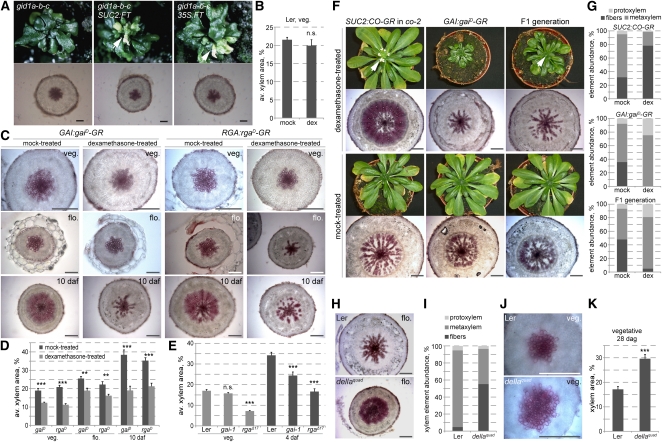Figure 4.
Control of Hypocotyl Xylem Expansion by GA Signaling.
(A) gid1a-b-c triple mutants that fail to flower (top) unless transgenes driving constitutive expression of the florigen, FT, are introduced. Transverse hypocotyl sections (bottom) were taken at 14 days after flowering of the transgenic lines for all lines. Arrowheads point out the inflorescence meristem and flower-like structures in transgenic plants.
(B) Control experiment demonstrating the absence of dexamethasone (dex) effects on xylem expansion in the Ler control background.
(C) Suppression of xylem expansion by dex activation of dominant-negative versions of transgenic GAI and RGA genes (gaiD and rgaD) fused with the glucocorticoid receptor domain (GR).
(D) Quantification of xylem area in the experiments illustrated in (C). Error bars are se.
(E) Reduced xylem expansion in the rgaΔ17 and the gai-1 mutants compared with their Ler background at vegetative state and after flowering. Error bars are se.
(F) Suppression of xylem expansion by dex activation of dominant-negative transgenic GAI and simultaneous dex induction of flowering and, thus, xylem expansion through the SUC2:CO-GR transgene. Arrowheads point out the inflorescence meristems.
(G) Quantification of xylem element abundance in the hypocotyls sampled in the experiment illustrated in (F).
(H) Enhanced xylem expansion at flowering in the rga-24 gai-t6 rgl1-1 rgl2-1 quadruple loss-of-function mutant (dellaquad) compared with its Ler background (dellaquad at 36 d after germination; Ler at 42 d after germination).
(I) Quantification of xylem element abundance in the hypocotyls sampled in the experiment illustrated in (H).
(J) Xylem expansion in hypocotyls of Ler and dellaquad plants at same age vegetative state (28 d after germination).
(K) Quantification of xylem area in the experiment illustrated by examples in (J). Error bars are se. daf, days after flowering; n.s., not significant; *P < 0.05; **P < 0.01; ***P < 0.001. Bars = 200 μm.

